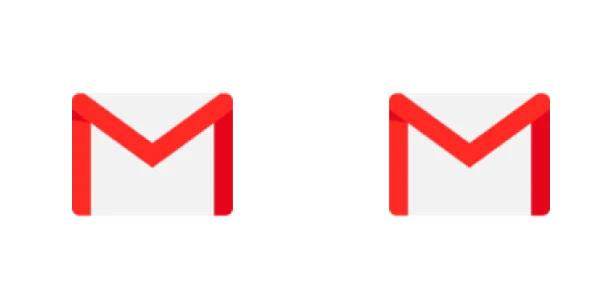People are busy. And we live in a world full of distractions. So every now and then, your emails might go unnoticed. Happens to the best of us. But if you leave it at that, minutes might turn into hours, hours into days and days into weeks… And you still won’t get that much awaited reply. That’s where follow-up emails come in.
In this quick guide, we’re going to show you how to craft, send and automate the perfect follow-up email. So that you get more replies. In less time.
What is a follow-up email?
Let’s start with the basics.
A follow-up email is basically a reminder. A gentle nudge designed to prompt a response from someone you have already contacted.
There are several situations in which you may want to send a follow-up email to keep the conversation going:
- When your first email has been ignored
- After a networking event
- After a call with a client
- After a job interview
- After a meeting
The most effective follow-up emails are short, clear and actionable. They are usually divided into 4 parts:
Why send a follow-up email?
The average professional receives 126 emails per day. And while a majority of emails receive a response within 1 hour, others can get lost in your recipient’s inbox.
Whether your recipient missed your first email, forgot to get back to you or deliberately ignored you, sending them a polite follow-up email will increase your chances of getting a reply.
According to research, a single follow-up can increase your response rates by a whopping 65.8%, allowing you to generate more revenue and build a stronger connection with your recipients.
How to write a follow-up email after no response?
There is a science to writing follow-up emails that generate a high response rate.
And it all breaks down to simple steps:
4 steps to write a high-performance follow-up email
To crank out your follow-up mails faster and get more replies, you can follow this proven 4-steps formula:
Step 1: Write a killer subject line
As research shows, 47% of all emails are discarded by recipients because their subject line is too dull. Your journey to crafting the perfect follow-up email therefore starts with finding a great subject line.
The only job of your subject line is to give your recipient an irresistible urge to click on your email. The trick to do that is to build curiosity.
You want your subject line to be brief.
Five words top.
Why?
Because 56% of emails are read on a mobile device. If your subject line is too long, it might get cut halfway through.
Here are a few examples of subject lines that have worked well for us so far:
- RE: Question
- (no subject)
- Partnership
Don’t recycle the subject line you used in your previous email. There may be a reason why the recipient skipped that email. If you use the same subject line, your follow-up email may be ignored as well.
Lastly, avoid using spam words. Those words tend to trigger the spam filter of your recipient’s mailbox. If you don’t want to end up in the junk folder, stay clear of words such as “Urgent”, “100% free” or “Once in a lifetime”.
We’ve built a free Spam Words Checker to quickly highlight words that could be considered spam in your email. You may want to check it out.

If you are sending your follow-up email to several recipients, don’t forget to A/B test your subject lines to find out what works best for your audience.
Alternatively, you can test the performances of your email’s subject thanks to our free subject tester tool.
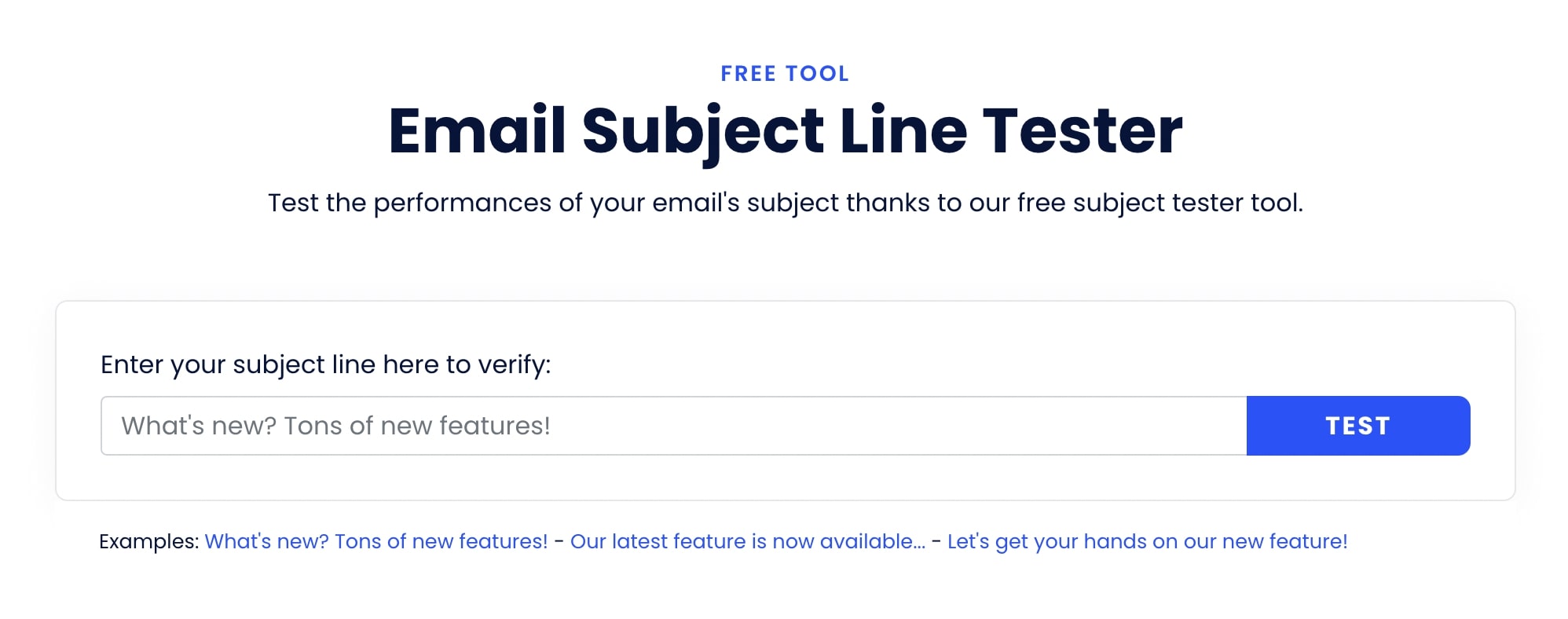
Step 2: Rework your opening line
You got your recipient to open your follow-up email. That’s great! Now you need to give them a reason to keep reading. If you do not hook their attention with a great opening line, they will be gone before you know it. And your email will be forgotten forever.
To avoid that, start by giving them a clear context. Why are you contacting them? A good practice is to remind the recipient about the content of your previous exchange. They might not remember who you are. But there is a better chance that they will answer to someone who has contacted them before.
Here are a few opening lines that you can use in your follow-up emails:
- Did you get a chance to read my previous email?
- I’m about to archive this discussion as I haven’t heard back from you.
- This email popped back up to the top of my inbox, so I wanted to check in!
- I saw that you are {{ action }}. How’s that going?
- Just a quick follow-up to see your thoughts about {{ topic of email }}.
- I promise this mail isn’t as long as the last one :)
Finally, your introductory line will be even more effective if you can create a personal connection with your recipient. Do you share a common interest? Or is there something that can help them remember you? Try to re-engage your recipient by showing them that you are not just a random stranger.

Step 3: Add value to your email
Responding to emails can be very time consuming. On average, employees spend around 28% of their work time on email. So if your follow-up email does not add value, people won’t bother. Keeping only your own interest in mind is the best recipe for disaster. Simple as that.
Below are a few ways you can provide value to your recipient:
- Offer a solution to their problem
- Give them a special discount
- Send them a free e-book
- Offer them a free trial
- Ask for their opinion
Additionally, you can add social proof in your follow-ups to build trust. The best way to do this is to include client testimonials, previous projects you’ve worked on, or a case study.
Step 4: Finish with a compelling call-to-action
Don’t leave your recipient wondering what the next step should be. End your email with a strong call-to-action (CTA) to nudge them in the right direction.
To do that, ask yourself: What is the goal I am trying to achieve with this email? How will I measure success?
For example, your goal could be to get your recipient to book a demo. Or to hop on a sales call with you. Or simply to answer your questions.
Whatever it is, make sure to ask for it. And do it in a clear and concise way. At this point, the last thing you want to do is to confuse your recipient.
Below are a few examples of call-to-actions you might want to use in your follow-up email:
- How are you feeling about going forward with this project?
- Still want to work together? No wrong answers! :)
- Please feel free to reply if you still need assistance.
- Would you have 10-15 free to chat next week? (I promise to keep the time!)
- I’m eager to make this super easy for you. What can I do to help?
3 bonus tips to nail your next follow-up email
Now that you know how to write high-performance follow-up emails, let’s take it to the next level with these 3 bonus tips.
How many follow-up emails should I send?
According to research, 60% of customers we conducted, most recipients say no 4 times before saying yes. But at the same time, you don’t want to overdo it and sound too pushy.
When to send a follow-up email?
Finding the right timing to send your follow-up emails can be a bit tricky. A good practice is to wait at least a couple days before sending your first follow-up. But what if you still don’t get a reply? How long should you wait before sending your next round of follow-up emails?
The key here is to give the recipient more time to respond after each new email. This technique will reduce your chance of being marked as a spammer.
- Day 1: original email
- Day 3: 1st follow-up email
- Day 7: 2nd follow-up email
- Day 12: 3rd follow-up email
- Day 21: 4th follow-up email
- Day 35: last follow-up email
But if you have several email campaigns running at the same time, following your timeline can become overwhelming. That’s where automation comes in.
How to automate your follow-up email sequence with Gmail?
Mailmeteor lets you send a simple follow-up with Gmail as well as a multi-steps sequence over several days or weeks. Set up your email sequence in a few clicks. And then let Mailmeteor do the work for you.
Here’s how to send follow-up emails with Mailmeteor from Google Sheets:
Step 1: Open a new spreadsheet and insert your contacts list.
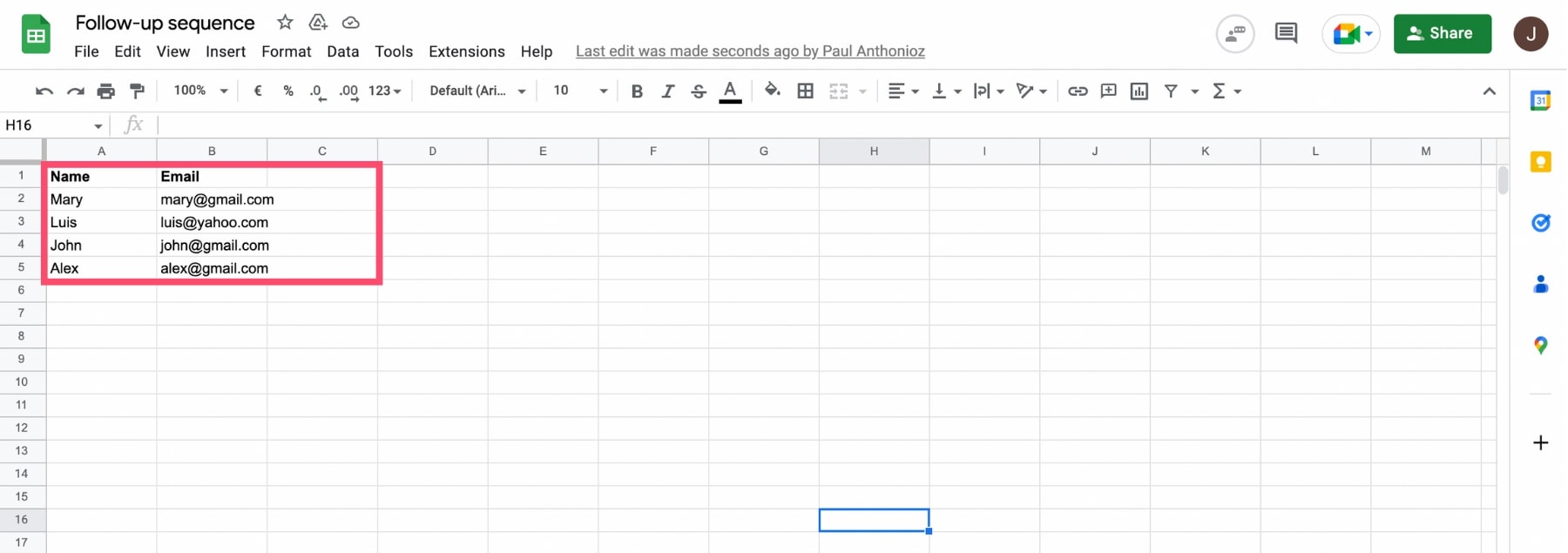
Step 2: Open Mailmeteor from the Extensions menu. Select Mailmeteor and click Open Mailmeteor.
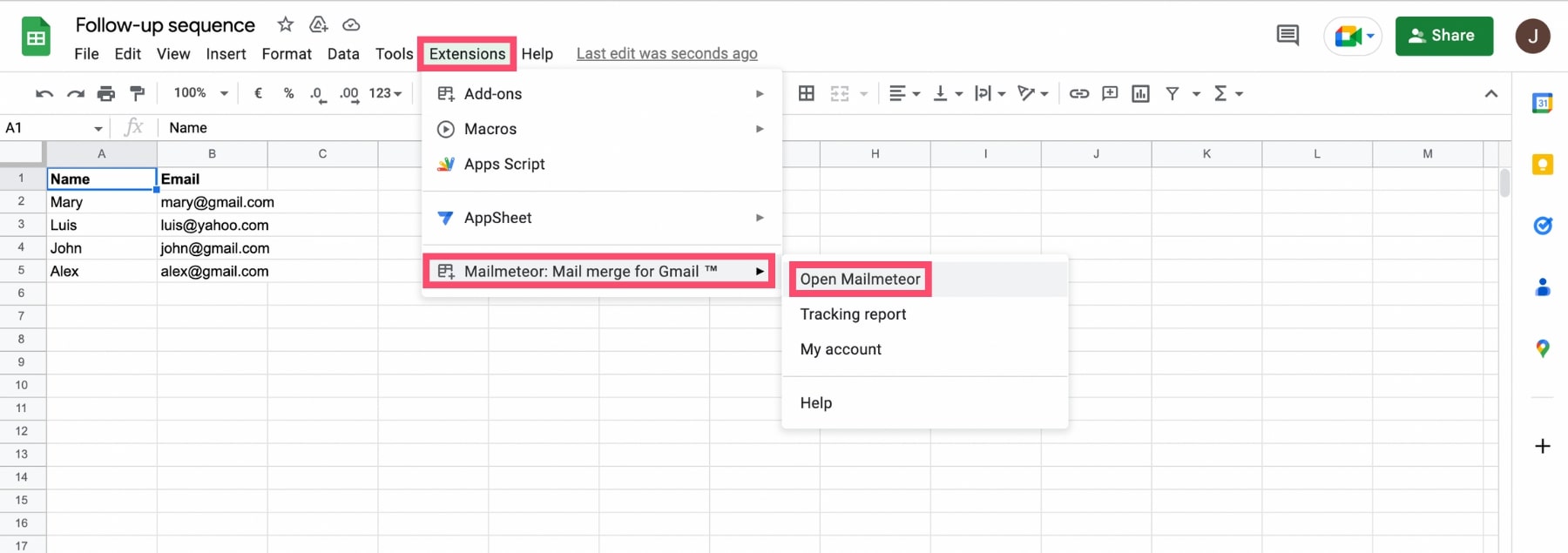
Step 3: Select a template or create a new one.
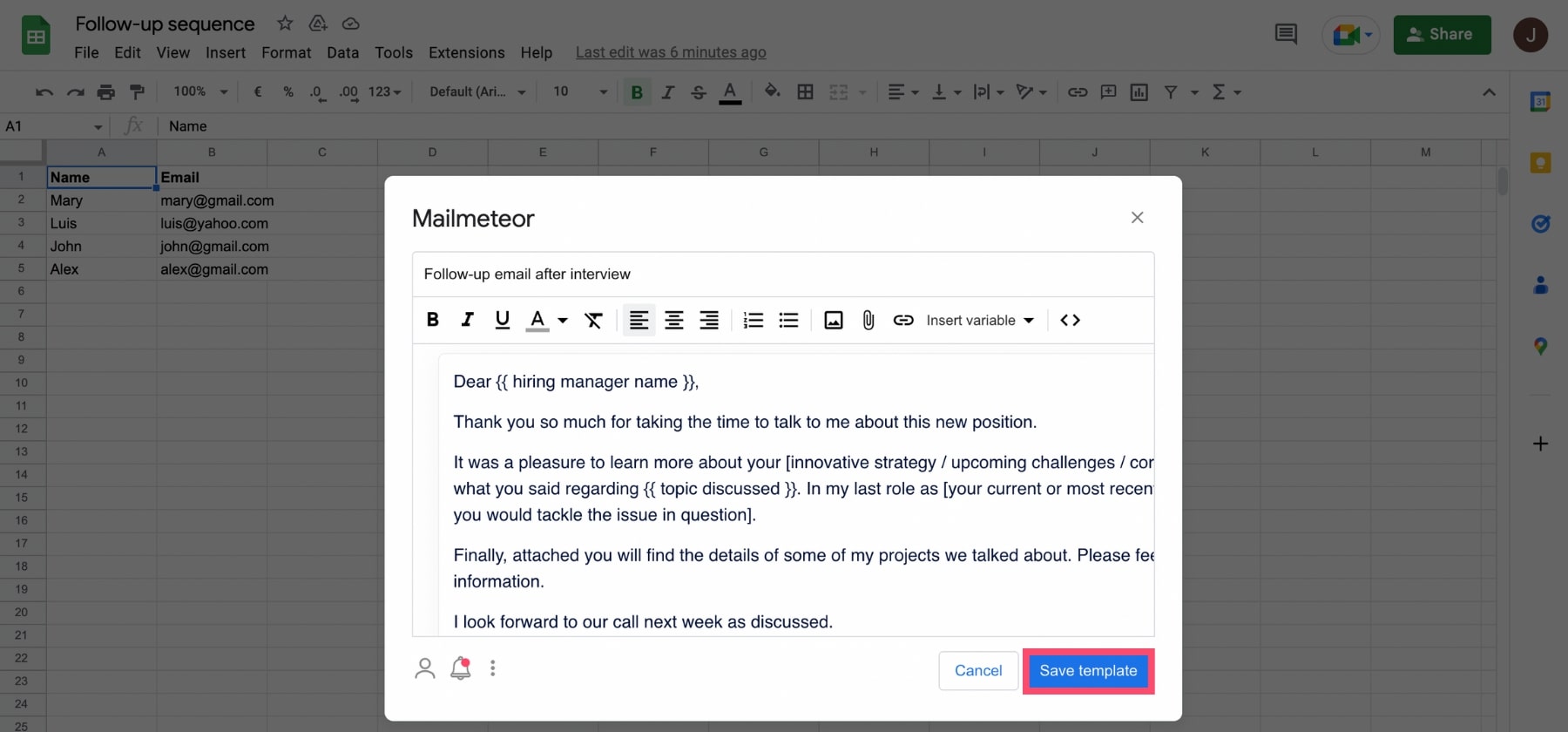
Then in the bottom right corner of the window, click on the dropdown menu and select Follow-up.
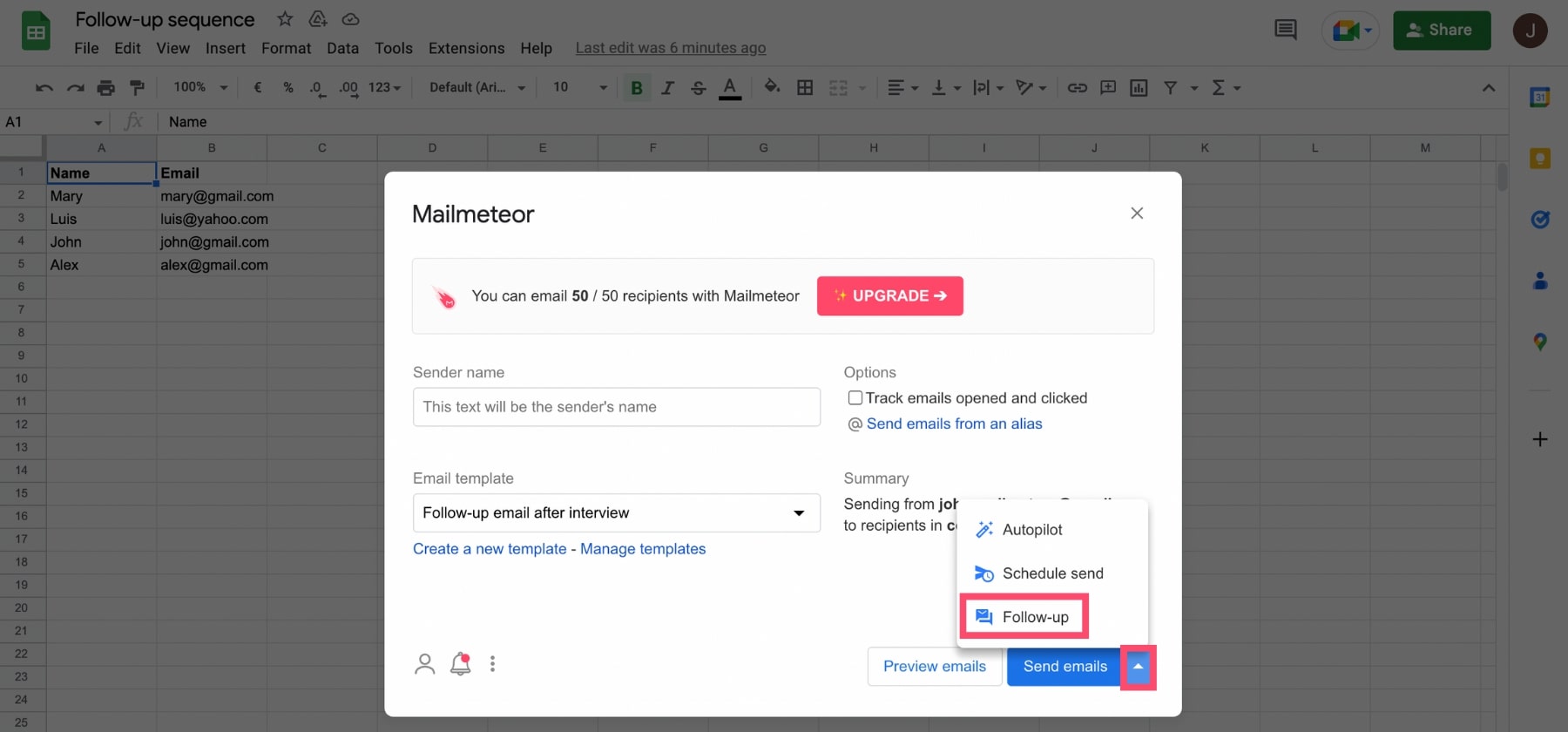
Step 4: Write your follow-up message and define when the follow-up should be sent.
You can specify a trigger (if the recipient didn’t respond for example) as well as an interval after which the follow-up should be sent.
Step 5: Once you’re ready, click on Send with a follow-up.

Boom. Easy as that.
3 polite follow-up email templates
Speaking of templates, we thought it might be helpful to share a few examples of follow-up emails after no response that have worked well for us here at Mailmeteor. If you’re struggling to find the right words, you can use these follow-up email samples to kickstart your writing process and avoid blank page syndrome.
For more free templates, you can also check this list of 10+ very short follow-up email examples. Hope this helps :)
Job interview follow-up email template
Subject: Pleasure to learn more about {{ company }}
Dear {{ firstname }},
Thank you for your time today. It was a pleasure to learn more about {{ company }} and I was happy to hear that you share my background in {{ industry }}. I look forward to discussing the {{ jobtitle }} role with you in more detail.
Please find my resume and cover letter attached to this email. And let me know if you require any additional documents.
Sincerely, John
Networking follow-up email template
Subject: Free for coffee?
Hello {{ firstname }},
It was great to meet you last night at {{ event }}. I really enjoyed our chat about {{ topic }} and I thought I’d share a blog post I found very useful on that matter. Here’s the link: {{ link }}. I hope you enjoy it.
I would love to discuss your approach to {{ topic }} in more detail. Can we meet for a 20-minute coffee break next Friday?
Best, John
Sales follow-up email template
Subject: RE: Question
Last we chatted, you requested that I get back in touch in January.
I would be delighted to share with you our know-how in {{ industry }} and to present you our {{ product }}, used by more than 5,000 companies in Europe.
It would allow you to {{ benefit1 }} and to {{ benefit2 }}.
What do you think?
Please let me know if you are available to hop on a 10-minute call. I promise I’ll make it worth your while.
Best regards,
John
Let’s wrap it up
Follow-up emails are an essential part of your emailing strategy. Adding one or several follow-up emails to your email campaigns can help you achieve higher conversion rates, generate more response and bring in new business.
In this guide, you have learned how to craft, send and automate a polite follow-up email after no response. You’ve seen that it’s really easy to do so, using both Google Sheets and a mail merge solution such as Mailmeteor.
Now, all that’s left to do is to plan your follow-up email sequence. You can do that using our premium plan. Which will also give you access to extra features, such as a real time tracking report. Happy sending!
![]()
